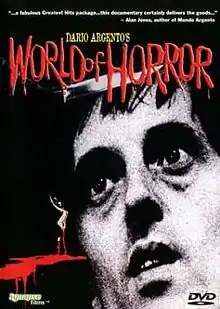Dario Argento's World of Horror
Dario Argento's World of Horror (Italian: Il Mondo dell'orrore di Dario Argento) is an Italian documentary film that chronicles the career of Italian director Dario Argento.
| Dario Argento's World of Horror | |
|---|---|
 DVD cover | |
| Directed by | Michele Soavi |
| Produced by | Michele Soavi |
| Written by | Michele Soavi |
| Starring | Dario Argento Urbano Barberini Ken Foree Romano Albani |
| Music by | Claudio Simonetti |
Running time | 76 minutes |
| Country | Italy |
| Language | English Italian |
The documentary features candid interviews with Argento and various stars from films he has directed, as well as extensive clips and behind-the-scenes footage of his films. The film includes segments focused on subjects as the soundtrack work, coloring and color filtering, and camerawork in Suspiria, the soundtrack for Inferno, the camerawork and insect effects in Phenomena, Tom Savini's make-up work in Dawn of the Dead, and the special effects, make-up and robotics in Dèmoni as well as interviews with Argento on a variety of esoteric subjects. Because most of Argento's films were only available in heavily edited form at the time, Dario Argento's World of Horror was sought after by many fans of the director's work because it contained numerous clips of footage removed from the released films, most notably the opening double murder sequence from Suspiria.
Reception
From contemporary reviews, an anonymous reviewer in Fangoria, who found the film "fascinating but also strangely endearing" noting that the documentary was "a delightful eye-opener, An Americans who want to know what all the fuss is bout this visionary writer-director can get a good start here."[1] Tim Lucas wrote in Fangoria that the documentary was "fascinating" and offered many scenes that were at the time cut from American releases of Argento's films including The Bird with the Crystal Plumage, The Cat o' Nine Tails, Four Flies on Grey Velvet, Tenebrae and Suspiria. [2] Lucas also proclaimed that the films "real accomplishment is its portrat of Argento's professional intensity and dedication; he cleary deserves to be taken more seriously by American film audiences, critics, and distributors."[2]